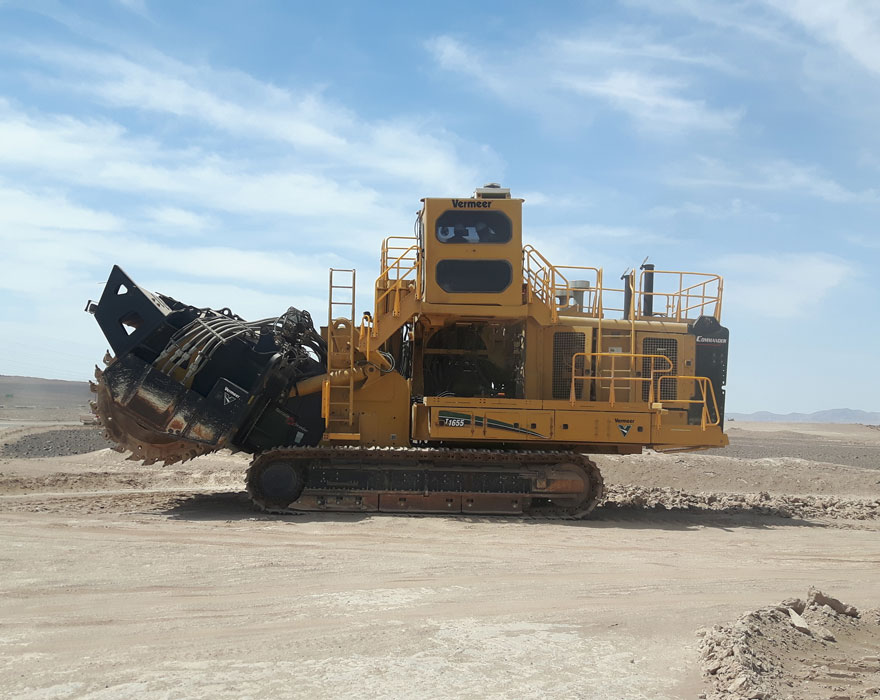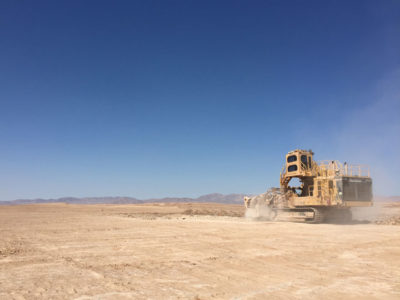In 2017, a prominent non-metallic mine in Iquique, Chile, began using precision surface mining methods. The mine had a goal of taking a broader approach and evaluating the benefits of precision surface mining from pit to heap leach. Results have been measured and compared with traditional drill and blast methods, and after almost 3 Mt of material cut, the benefits are sound and clear. The mining operation has reported positive results in the areas of material separation, better access in areas that were off limits before, more consistent particle sizes and gains in the heap leaching process.
César Leite, Vermeer Regional Manager for Chile and Specialty Excavation, said that surface mining operations throughout the region have put precision surface mining machines, like the Vermeer T1655 Commander® 3 Terrain Leveler® surface excavation machine (SEM), to work and been happy with the results. “We’ve helped many surface mining operations in the region deploy precision surface mining methods that help address many challenges associated with traditional methods,” he explained.
Safety
Safety while working with explosives used for drilling and blasting has been a major focus area for the mines in Chile. “It is not just the nature of the traditional process that makes it risky, but the number of people involved,” Leite said. “With the precision surface mining process, workers have a controlled way of extracting material, and the process does not have a single step where high levels of energy are stored and released.”
Precision work
Precision surface mining has also helped dilution issues because of the way the Terrain Leveler SEM cuts material in layers. With a modulable cutting depth, miners can be highly selective in the way they recover the mining ore with minimum presence – if any – of sterile material. Geological mapping of the pit can result in less dilution. It can help improve efficiencies through the whole process from loading and hauling of rich and concentrated mineral ore to a heap leaching process with a high level of mineral recovery.
Exclusion areas
The amount of energies stored and released by blasting can cause significant ground vibration, which is why many mines have areas that are off limits to traditional methods. Selective surface mining has provided a unique solution for some Chilean mines, by exploiting these massive areas otherwise prohibited. Using surface mining machines has opened about 80,000 sq.m of new areas in Chile near roads, warehouses, medium voltage lines and other areas previously unavailable.

Particle size
In non-metallic surface mining operations, the effectiveness of the leaching process can be affected by the direct particle size output of the blasting stage. “In normal conditions, blasting is simply not able to control or guarantee a consistent particle size,” Leite explained. “Inconsistent particle sizing can result in poor recovery during heap leaching stages. With selective surface mining, there is a high level of consistency in particle sizes, which can result in better mineral recovery in latter heap leaching stages. On top of that, avoiding big chunks of rocks – very common in blasting – increases the efficiency of the hauling process as more material is transported in a given spatial volume.”
Around 95% of the material cut with the Terrain Leveler SEM produced particle sizes below 25.4 cm.
Heap leaching process
As with every mining activity, there are details that will provide a clear insight into any improvements introduced in previous stages. In some of the non-metallic mining operations, heap leaching is the key process that will clearly show the benefit of a given innovation. The heap leaching process happens slowly, so – although the insight is clear – it takes time to realise the benefit of any given change in the previous stages. The required time for a heap to deliver all the mineral recovered may vary depending on heap dimensions, particle size consistency, leach solution and some other factors. On average, 12 months seems to be a very common time frame for a heap to deliver its benefits. Naturally, the shorter the period, the better to recover the same amount of mineral, but if there’s even more mineral recovered, then it is simply a remarkable result. This is precisely what was observed in Chile: more mineral recovered in less time.
The results of mineral recovery at heaps created exclusively by selective surface mining with the Vermeer Terrain Leveler SEM showed 12% more mineral recovery than heaps with traditional mining. This mineral recovery rate was achieved in a period 33% shorter than using traditional mining methods.










